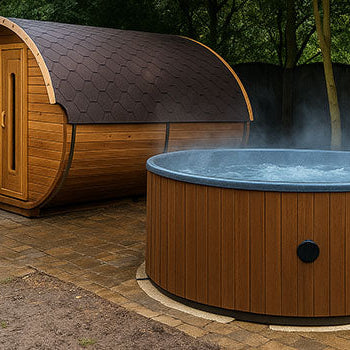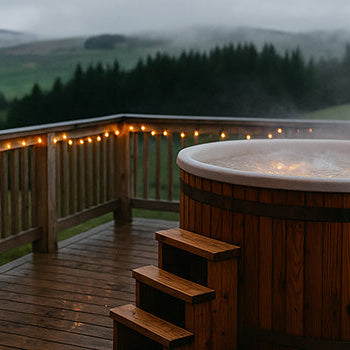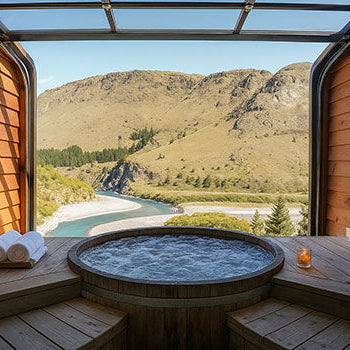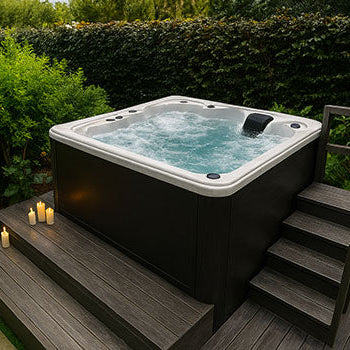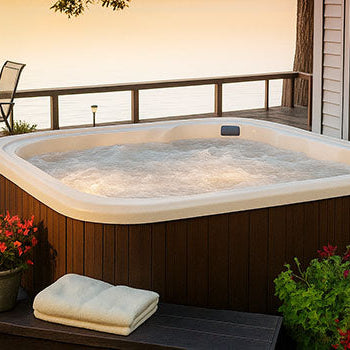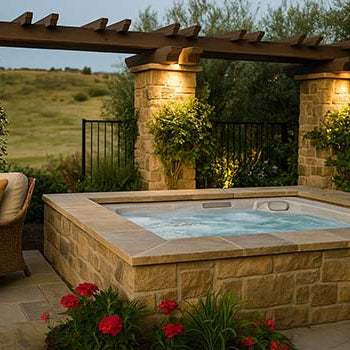Thinking of soaking without sinking your savings? You’re not alone. Plenty of homeowners dream of relaxing in their own garden spa but get stuck choosing between a hot tub and a swimming pool.
So, let’s get to the point: yes, hot tubs are cheaper than pools, often by a long way.
Whether you're eyeing a sleek acrylic spa, a tough rotomoulded model, or a charming old-school wooden tub, there’s a bubbly solution for every budget. Keep reading to find out exactly where the costs stack up, and where they don’t.

Comparing Initial Purchase and Installation Costs
Hot Tub Installation Costs Recap (Base, Electrics, Delivery)
Hot tubs are like plug-and-play spa dreams... with a bit of prep. You'll need a flat, stable surface, most folks go with a concrete slab or reinforced decking.
You'll also need a dedicated 240V electrical supply. This isn’t a DIY job, so get a qualified electrician in. As for delivery, most suppliers include it, but if your access is tricky (think: narrow side gate or lots of steps), expect an extra charge.
Typical installation costs land between £500 and £2,000 depending on how ready your garden is to begin with.
Swimming Pool Installation Costs (Excavation, Construction, Lining, Filtration, Landscaping – Significantly Higher)
Installing a pool is a whole different animal. You’re looking at excavation, filtration systems, lining, plumbing, and often, a full garden redesign.
In-ground pools usually require weeks of work and specialist planning, not to mention possible planning permission headaches in the UK.
Costs start around £25,000 and can easily top £75,000, especially if you add extras like lighting, decking, or heating systems.
Cost Difference for Above-Ground vs. In-Ground Pools
Above-ground pools are much lighter on the wallet. Inflatable or framed options can start around £300 and go up to £5,000. But while they're budget-friendly, they often don’t last as long and can look a bit out of place in a stylish garden.
In-ground pools, on the other hand, offer the wow factor, but with the price tag to match.
Winner: Hot Tubs Typically Have Much Lower Installation Costs
No contest, hot tubs win this round. Even premium models cost less to install than the most basic in-ground pool.
Comparing Ongoing Running Costs
Heating Costs: The Biggest Variable (Hot Tubs Heated vs. Unheated/Heated Pools)
Here’s where things start to vary wildly.
Hot tubs are always heated. They’re smaller and better insulated, so keeping them toasty usually costs around £30 to £50 per month.
Now, a heated pool? That’s a different story. You could easily be looking at £80 to £150+ per month, depending on the size and how warm you want it. But if the pool’s unheated? Your wallet will thank you, though your toes might not.
Water Usage: Pools Hold Vastly More Water (Higher Initial Fill/Top-up Costs)
Let’s talk volume.
A hot tub uses about 1,000 to 1,500 litres. A standard pool? More like 20,000 to 50,000 litres.
That’s a massive difference when it comes to filling, topping up, or heating all that water. You’ll definitely feel it on your water bill.
Electricity for Pumps and Filtration (Pool Pumps Run Longer but Tub Heaters Use More Power)
Hot tubs use more power for heating but in shorter, controlled bursts. Pool pumps, on the other hand, run for hours a day to keep the water clean, especially in the summer.
Both eat up electricity, but in different ways. The total impact depends on how often you’re using them.
Chemical Costs Comparison (Volume vs. Concentration)
With fewer litres to treat, hot tubs need fewer chemicals, but they need more frequent attention.
Pools need larger quantities, but the routine can sometimes feel a bit easier to spread out. Still, larger water volume equals more spending, especially for big pools.
Winner: Highly Dependent (Unheated Pool cheaper to run than Hot Tub; Heated Pool MUCH more expensive)
Here’s the honest answer: it depends.
If you’re not heating the pool, it’ll cost less to run than a hot tub. But once you add heat? Hot tubs become far more energy-efficient.

Comparing Maintenance Costs and Time Commitment
Hot Tub Maintenance Recap (Water Testing, Filters, Draining)
Owning a hot tub is a bit like having a pet fish; small, manageable tasks keep things clean and happy.
You’ll be testing water weekly, cleaning filters monthly, and giving the whole thing a drain and scrub every 3–4 months. It’s easy once you get into the rhythm, and plenty of folks even find it a bit therapeutic.
Pool Maintenance Tasks (Skimming, Vacuuming, Backwashing, Water Testing, Winterising)
Pool owners, though? That’s a full-on relationship.
There’s skimming leaves, vacuuming the floor, brushing walls, and backwashing filters. Come winter, you’ll also need to shut it down properly, or pay someone who can.
The job list is longer, and so is the time commitment.
Chemical Complexity and Volume
Pools need more chemicals, and the balancing act is often trickier. You're not just chucking in chlorine, there’s pH, alkalinity, stabilisers, and more.
Hot tubs? Simpler, but they still demand consistency. Miss a treatment and you’ll know about it.
Time Investment Comparison
Hot tubs usually need 15–30 minutes a week. Pools? Easily an hour or more, especially in warm weather.
If you plan to outsource? Be prepared to pay.
Professional Servicing Costs Compared
Hot tub servicing is relatively affordable. Most owners spend around £150 to £300 annually.
Pools can cost anywhere from £300 to £800+, especially with seasonal maintenance and equipment checks.
Winner: Hot Tubs Generally Require Less Time and Lower Volume Maintenance, Though Tasks are Frequent
Hot tubs come out ahead, again.
They need more regular upkeep, but the tasks are short, manageable, and cost far less over time.
Comparing Lifespan and Major Repair Costs
Hot Tub Lifespan Recap (5–20+ Years)
A well-kept hot tub can last anywhere from 5 to 20 years, depending on the build.
Acrylic models often last the longest. Rotomoulded tubs are tough and rugged, ideal for families. And wooden tubs, with their natural charm, can last over a decade if treated well.
Pool Lifespan (Liner Replacement, Structural Repairs)
Pools may last longer, but they don’t age quietly.
Liners wear out, filters clog, and structural cracks can form in older concrete designs. You might get 30+ years from the shell, but you’ll be replacing parts every few years.
Potential Major Repair Costs Compared
Need to replace a hot tub heater or pump? That might cost £200–£750.
Pool repairs? You’re often into the four-figure range. Liner replacements alone can hit £2,000 or more.
Overall Cost of Ownership Summary
Hot Tubs: Lower Entry Barrier, Consistent Running/Maintenance Costs
Hot tubs are budget-friendly to buy and easy to manage.
Running costs are steady, and maintenance is totally doable, even for first-timers. Whether you go acrylic, wooden, or rotomoulded, it’s a smooth ride overall.
Pools: High Entry Barrier, Running Costs Vary Hugely (Heating is Key), Significant Maintenance
Pools come with a high upfront cost, and everything from heating to seasonal care can make costs balloon.
Yes, they’re great for laps and parties, but for most households? They’re a serious investment in both time and money.

Conclusion: Hot Tubs are Generally Cheaper to Install and Own Than Heated Pools; Unheated Pools Have Lower Running Costs but High Install Costs.
If you're dreaming of backyard water bliss, the verdict is in: hot tubs are cheaper to install, easier to run, and far less effort to maintain, especially compared to heated pools.
While unheated pools can be cheaper to run, they still cost a small fortune to install.
So whether you’re drawn to the rustic warmth of a wooden tub, the toughness of a rotomoulded spa, or the sleek luxury of an acrylic hot tub, you’re better off soaking than swimming.
